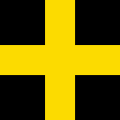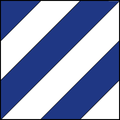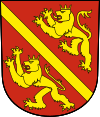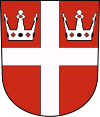Flags and arms of municipalities of Switzerland
This article is missing information about descriptions of the flags. (May 2022) |
This article needs additional citations for verification. (July 2024) |
This is a list of flags and coats of arms of the municipalities of Switzerland.
Aargau
[edit]| Name | COA | Flag | Colours | Blazon and Symbolism | Date |
|---|---|---|---|---|---|
| Aarau |  |  | Under a red shield head in white, red armored and tongued black eagle. The municipal flag and the coat of arms from 1270 showed an eagle and a three-leaved linden tree with flowers. An illustration of the coat of arms in the Tschachtlan chronicle from 1470 does not contain the linden tree, but a red shield head can be seen above the eagle for the first time. The eagle owes its use as the heraldic animal of the city of Aarau to a folk etymological reinterpretation of the name as “Au des Aars”. | 1270 | |
| Aarburg |  |  | |||
| Baden |  |  | Below the red shield head in white black pole. The first documented use of the city seal is on a certificate of 25 February 1311. It showed, washed by spring water and surrounded by vines, a swimming pool in which a man and a woman sit and eat grapes. It was in use until 1497; in addition, there were six similar seals, which were used until about 1800. The hospital had its own seals (a hand in front of the Greek cross that extends two fingers). The first documentary mention of the Baden city banner dates back to 1361. The municipal regiment took it to the Battle of Sempach in 1386; the oldest pictorial representation can be found in the Tschachtlanchronik in 1470. Its meaning is unknown but it is believed to come from the Counts of Lenzburg or Austria. In 1441, the first representation of the banner in a coat of arms, cast in iron, was placed above the gate of the city tower, with the exaggerated imperial eagle, which was to clarify the theoretical status as a Free Imperial City. The meaning of the coat of arms and the flag has not been handed down. It may be due to the Counts of Lenzburg-Baden, or it is a derivative of the red-white-red Austrian coat of arms. The coat of arms and the flag are still considered the district coat of arms and flag. | 1311 | |
| Lenzburg |  |  | 1333 | ||
| Unterentfelden |  |  | |||
| Zofingen |  |  | Per bend argent and azure. The colours of the stripes come from the flag of Austria. | 1387 |
Former municipalities
[edit]| Name | COA | Flag | Colours | Blazon and Symbolism | Date |
|---|---|---|---|---|---|
| Elfingen |  |  | Red, on a green three-mountain tattooed[clarification needed], a white double cross. Elfingen's symbol comes from the coat of arms of Hungary in honor of the relationship between the Königsfelden Monastery and Agnes of Austria. Adopted on 5 May 1953. | 1245–2022 |
Appenzell Ausserrhoden
[edit]| Name | COA | Flag | Colours | Blazon and Symbolism | Date |
|---|---|---|---|---|---|
| Grub |  |  | A yellow bear striding on a gold grassland inside a black circle on a white background. The coat of arms and the flag, which has been held in Grub since the early 19th century, shows the green forest in blue. A black bear emerges from a cave in front of it. In order to bring the coat of arms and the flag closer into connection with coat of arms and flag laws as well as with its deeper meaning, the black circular symbol for pit was used. Since this is black, the bear had to be made yellow. This makes it different from those in other municipal coats of arms and flags in the canton. | 19th century |
Appenzell Innerrhoden
[edit]Basel-Landschaft
[edit]| Name | COA | Flag | Colours | Blazon and Symbolism | Date |
|---|---|---|---|---|---|
| Anwil |  |  | Per pale Sable and Argent, in Chief Or | ||
| Dittingen |  |  | Argent, a Saint passant robed Sable, haloed and carrying a bag and a staff, and wearing sandals Or, on a Base Vert between two trees of the same trunked Gules | ||
| Rümlingen |  |  | On a gold background Saint George in blue armor with a red halo and red spear stabbing a black dragon. Saint George is the church patron and the colors gold and black represents the municipality's former affiliation to the Homburg rule.[1] | 1944 | |
| Ziefen |  |  | A lying black eagle with golden beaks on a white background. It is the flag and the coat of arms of the Eptinger von Ziefen, as can be seen on a glass pane from 1583.[2] | 1943 |
Basel-Stadt
[edit]| Name | COA | Flag | Colours | Blazon and Symbolism | Date |
|---|---|---|---|---|---|
| Basel |  | 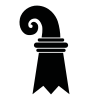 | Argent, a crosier paleways sable | 13th c. |
Bern
[edit]| Name | COA | Flag | Colours | Blazon and Symbolism | Date |
|---|---|---|---|---|---|
| Aarwangen |  |  | Per pale sable and argent a bar of the first. | 1341 | |
| Amsoldingen |  |  | Azure a buckle or. The coat of arms and the flag belongs to the "von Amsolt" family. | 1955 | |
| Bern |  |  | Gules, on a bend or a bear passant sable armed, langued, and pizzled of the field. | 13th c. | |
| Biel/Bienne |  |  | Gules two axes argent in saltire. The coat of arms and flag first appear on the city seal in the middle of the 13th century and show a man in a tunic with an ax in his right hand and a coat of arms with crossed axes in his left. The historian Heinrich Türler (1861–1933) assumed that this figure was the Meier von Biel and thus the former landlord: Biel was originally a manor (Fronhof) within a rule - probably the Count of Fenis-Neuenburg - which was administered by a Meier. As Lord of Biel he was raised to the knighthood. The coat of arms and flag with the crossed hatchets still represent the official coat of arms and flag today. | 13th c. | |
| Teuffenthal |  |  | Or, a pall gules. It is the coat of arms and the flag of a Thun mayor, Konrad von Teuffenthal, in 1322. It was adopted by the community in 1945.[3] | 1945 |
Fribourg
[edit]| Name | COA | Flag | Colours | Blazon and Symbolism | Date |
|---|---|---|---|---|---|
| Echarlens |  |  | Pally of six argent and gules overall in chief a mullet of five or | ||
| Fribourg |  |  | Azure a castle embattled and towered on dexter issuant from a semi annulet all argent | 1225 | |
| Montagny |  |  | Paly of six or and gules and a chief argent | ||
| Tafers |  |  | Gules, a guard stantant afrontee clad azure and sable ensigned with a cross on sinister, holding in dexter a halberd argent. |
Former municipalities
[edit]| Name | COA | Flag | Colours | Blazon and Symbolism | Date |
|---|---|---|---|---|---|
| Alterswil |  |  | Gules, a fleur de lis argent | ||
| Autafond |  |  | Per pale argent and gules three roses counterchanged barbed and seeded proper | ||
| Autavaux |  |  | Gules, a chevron or between two mullets of five and a crescent of the same and on a chief argent a rose of the first barbed and seeded proper | ||
| Bollion |  |  | Gules three mullets argent pierced in bend | ||
| Bussy |  | Gules, a lion rampant or, overall a bendlet compony or and azure | |||
| Corserey |  |  | Quartered gules and azure | ||
| Font |  |  | Gules, a mullet argent pierced | ||
| St. Antoni |  |  | Per fess or a tau cross issuant with two bells sabls and azure three annulets argent |
Genève
[edit]| Name | COA | Flag | Colours | Blazon and Symbolism[4] | Date |
|---|---|---|---|---|---|
| Geneva |  | 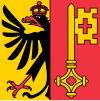 | Per pale: first or, an eagle with two heads dimidiated per pale sable crowned, armed, and beaked gules; second gules, a key paleways or | 15th c. | |
| Pregny-Chambésy |  |  | Quartered obliquely by blue and yellow in the wavy cut. | 28 November 1924 |
Glarus
[edit]| Name | COA | Flag | Colours | Blazon and Symbolism[5] | Date |
|---|---|---|---|---|---|
| Glarus |  |  | A bend wavy argent between:
The bend represents the Linth river. The three yellow stars represents Ennenda, Netstal and Riedern, while the black and white star represents Glarus. Both the coat of arms and the flag combine the symbols of all the former municipalities. | 2011 | |
| Glarus Nord |  |  | On a yellow background is a blue wave that flanked by four six-pointed stars. The four stars to the left of the wave represents Bilten, Niederurnen, Oberurnen and Näfels while the four stars on the right represents of Mühlehorn, Obstalden, Filzbach and Mollis. The blue wave represents the Linth river. Yellow and blue is the traditional colours of the municipality. | 2011 | |
| Glarus Süd |  |  | On a blue background is a golden sun with 17 rays above a silver wavy chevron. The sunrays represents Mitlödi, Sool, Schwändi, Schwanden, Nidfurn, Haslen, Leuggelbach, Luchsingen, Hätzingen, Diesbach, Betschwanden, Rüti, Braunwald, Linthal, Engi, Matt and Elm. The white V-shaped wave symbolizes the confluence of the Linth and the Sernftal rivers. Blue stands for water which is a vital resource for the municipality. | 2011 |
Graubünden
[edit]| Name | COA | Flag | Colours | Blazon and Symbolism[6] | Date |
|---|---|---|---|---|---|
| Albula/Alvra |  |  | In red, seven five-pointed golden stars (2, 2, 2, 1) arranged in a circle over two silver-blue waves. The seven former communities of Alvaneu, Alvaschein, Brienz/Brinzauls, Mon, Stierva, Surava and Tiefencastel have been united under the name Albula/Alvra since 2015. The seven stars refer to the number of congregations united. The wavy shield base is intended to symbolize the Albula River. Adopted on 1 January 2015. | 2015 | |
| Andeer |  |  | Argent a bear rampant Sable langued and viriled Gules and a base embattled of the second. As a canting representation, the coat of arms refers to the Bärenburg castle and its historical significance for Andeer, with the bear alluding to the name and the crenellation to the castle (Bärenburg). Under the barons of Vaz and the Count v. Werdenberg-Sargans castle was the seat of the court and administration over the valley, at the time of the violent bailiff Hans v. Rechberg, it was stormed and destroyed. | ||
| Arosa |  |  | Azure a Sun in splendour Or and a base dancetty Argent. The coat of arms, approved by the local council resolution of December 12, 1934 and by community vote on February 22, 1935, was designed by Paul Ganz, art historian at the University of Basel, and Friedrich Pieth, history teacher at the Chur Cantonal School. The two mountains symbolizes the altitude of the mountain community as well as mining between the 14th and 15th centuries. The colors blue and gold indicate the former membership of the Zehngerichtebund. The golden sun on a blue background also represents the community as a holiday resort. Adopted on 22 February 1935. | 1935 | |
| Avers |  |  | Per bend Argent an Ibex passant Sable langued and viriled Gules and Sable. | ||
| Bergün Filisur |  |  | Argent a Griffin rampant Sable beaked and membered Gules. When the former municipalities of Bergün/Bravuogn and Filisur merged in 2018 under the name Bergün Filisur, the former Bergün district coat of arms was used. The Bergün district emerged from the old Greifenstein court, which the Greif indicates in the sense of a “talking” coat of arms. The colors are those of the church association to which the court belonged. The districts of the canton of Graubünden were dissolved on December 31, 2015. | 2018 | |
| Bever |  |  | Or St. James passant clad Azure holding in dexter a Crozier Gules and in sinister a Bible of the first. St. James the Elder was the patron of local church. It already appears on the community stamp and was also painted on the facade of the community center in 1927. Colors of the Upper Engadine district in reverse color sequence. | ||
| Bonaduz |  |  | Argent a Pall Azure and a Mullet Gules in chief. The drawbar symbolizes the importance of the landscape, which is characterized by the two arms of the Rhine and the union of the Rhine. At the same time, it points to the fork in the paths to the Splügen and Bernhardin, the Lukmanier and Oberalp passes and thus characterizes the location of the village at this key traffic point. The star represents the patronage of St. Anna or Maria. The coat of arms was proposed by the municipality of Bonaduz. | ||
| Bregaglia |  |  | Silver, with black salient ibex, red tongue, surmounting the black field crenellated in the Guelph style of 4 pieces. Bregaglia was created on 1 January 2010 and includes the previously independent municipalities of Bondo, Castasegna, Soglio, Stampa and Vicosoprano. The municipality of Bregaglia and the former Bergell district therefore cover the same area. The community adopted the district's coat of arms. The black, crenellated shield base symbolizes the former division of the valley into upper and lower portals and alludes to one of the valley's most striking landmarks, the “Müraia”. The heraldic animal and colors are those of the church association, to which Bergell belonged. | 2010 | |
| Breil/Brigels |  |  | In blue over three silver peaks, the middle one covering the two outer ones and covered with a black-lined red crenellated tower, all elevated by a sixteen-rayed yellow sun. In 2018, the three communities Andiast, Breil/Brigels and Waltensburg/Vuorz merged under the previous name Breil/Brigels. In the new coat of arms, each of the three communities is represented with a motif. The three white peaks stand for Brigels and symbolize the Brigelser Horns that are distinctive for the village: Cavistrau Pign (3220 m), Cavistrau Grand (3252 m) and Piz Trumpiv (3101 m). Waltensburg is represented by a red tower, which refers to the largest and oldest castle complex in the Surselva, Jörgenberg Castle (Munt Sogn Gieri). The name refers to Saint George's patronage of the church, around which the castle complex later developed. Andiast is represented by a sun. According to reports, the Andiasters found it difficult to define their own motif for their village. Of the three communities on the sun terrace above the Vorderrheintal, Andiast is the highest, and so its residents are a little more sun-drenched than the others. | 2018 | |
| Brusio |  |  | Gules a Cross Argent. After a seal from the second decade of the 17th century with the inscription: SVB HOC SIGNO VINCES, but adopted without inscription. The colors are those of the old common judicial community of Puschlav. | ||
| Buseno |  |  | |||
| Calanca |  |  | |||
| Cama |  |  | |||
| Castaneda | 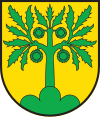 |  | |||
| Cazis |  |  | |||
| Celerina/Schlarigna |  |  | |||
| Chur |  |  | |||
| Churwalden |  |  | |||
| Conters im Prättigau |  |  | |||
| Davos |  |  | |||
| Disentis |  |  | |||
| Domat/Ems |  |  | |||
| Domleschg |  |  | |||
| Falera |  |  | |||
| Felsberg |  |  | |||
| Ferrera |  |  | |||
| Fideris |  |  | |||
| Fläsch |  |  | |||
| Flerden |  |  | |||
| Flims |  |  | |||
| Furna |  |  | |||
| Fürstenau |  |  | |||
| Grono |  |  | |||
| Grüsch |  |  | |||
| Ilanz/Glion |  |  | |||
| Jenaz |  |  | |||
| Jenins |  |  | |||
| Klosters |  |  | |||
| Küblis |  |  | |||
| La Punt Chamues-ch |  |  | |||
| Laax |  |  | |||
| Landquart |  |  | |||
| Lantsch/Lenz |  |  | |||
| Lostallo |  |  | |||
| Lumnezia |  |  | |||
| Luzein |  |  | |||
| Madulain |  |  | |||
| Maienfeld |  |  | |||
| Malans |  |  | |||
| Masein |  |  | |||
| Medel (Lucmagn) |  |  | |||
| Mesocco |  |  | |||
| Muntogna da Schons |  |  | |||
| Obersaxen Mundaun |  |  | |||
| Pontresina |  |  | |||
| Poschiavo |  |  | |||
| Rhäzüns |  |  | |||
| Rheinwald |  |  | |||
| Rongellen |  |  | |||
| Rossa |  |  | |||
| Rothenbrunnen |  |  | |||
| Roveredo |  |  | |||
| Santa Maria in Calanca |  |  | |||
| St. Moritz |  |  | |||
| San Vittore |  |  | |||
| S-chanf |  |  | |||
| Safiental |  |  | |||
| Sagogn |  |  | |||
| Samedan |  |  | |||
| Samnaun |  |  | |||
| Scharans |  |  | |||
| Schiers |  |  | |||
| Schluein |  |  | |||
| Schmitten |  |  | |||
| Scuol |  |  | |||
| Seewis im Prättigau |  |  | |||
| Sils im Domleschg |  |  | |||
| Sils im Engadin/Segl |  |  | |||
| Silvaplana |  |  | |||
| Soazza |  |  | |||
| Sufers |  |  | |||
| Sumvitg |  |  | |||
| Surses |  |  | |||
| Tamins |  |  | |||
| Thusis |  |  | |||
| Trimmis |  |  | |||
| Trin |  |  | |||
| Trun |  |  | |||
| Tschappina |  |  | |||
| Tschiertschen-Praden |  |  | |||
| Tujetsch |  |  | |||
| Untervaz |  |  | |||
| Urmein |  |  | |||
| Val Müstair |  |  | |||
| Vals |  |  | |||
| Valsot |  |  | |||
| Vaz/Obervaz |  |  | |||
| Zernez |  |  | |||
| Zillis-Reischen |  |  | |||
| Zizers |  |  | |||
| Zuoz |  |  |
Former municipalities
[edit]| Name | COA | Flag | Colours | Blazon and Symbolism[7] | Date |
|---|---|---|---|---|---|
| Almens |  |  | |||
| Bondo |  |  | |||
| Castasegna |  |  | |||
| Feldis/Veulden |  |  | |||
| Paspels |  |  | |||
| Pratval |  |  | |||
| Soglio |  |  | |||
| Stampa |  |  | |||
| Vicosoprano |  |  |
Jura
[edit]| Name | COA | Flag | Colours | Blazon and Symbolism | Date |
|---|---|---|---|---|---|
| Basse-Vendline | |||||
| Boécourt |  |  | Azure, a base vert, over all a yellow sheaf below three five-pointed yellow stars. The coat of arms and flag were taken from Bourquard de Boécourt, the eighth abbot of Bellelay from 1296-1316, with three additional stars in reference to the three villages of Boécourt, Montravon and Séprais. | 1945 | |
| Damphreux-Lugnez | |||||
| Grandfontaine |  |  | In yellow there is a black cross, the four fields are sown with five black shingles each (2,1,2). The coat of arms, adopted before 1900, goes back to the nobles of Grandfontaine, a branch of the Rocourt-Abbévillers, extinct in the 14th century. | Before 1900 | |
| Haute-Ajoie | |||||
| Haute-Sorne | |||||
| Pleigne |  |  | Gules, between three mullets of five or a sword and a staff argent in saltire and in chief on an inescutcheon of the last a jay stantant lined sable. The coats of arms and the flag are explained as follows: the sword and the hand of justice remind us that on the territory of the municipality is the Richterstuhl or Selle au Roi, a place where justice went; the stars, the dependence of the convent of Lucelle. The gai, which is the nickname of the village, was added at the request of the municipal authorities. | 30 May 1945 | |
| Saignelégier |  |  | Gold with a silver mirror bordered with sable, placed on six mountains of gules placed three by three. These are the old coat of arms and flag of the nobles of Spiegelberg, the remains of the castle of which are still visible at Rocher des Sommêtres, 2.5 km from Saignelégier.[8] |
Former municipalities
[edit]Lucerne
[edit]| Name | COA | Flag | Colours | Blazon and Symbolism | Date |
|---|---|---|---|---|---|
| Hergiswil bei Willisau |  |  | 18th c. | ||
| Lucerne |  |  | Per pale azure and argent (flag: Per fess argent and azure) | 14th c. |
Former municipalities
[edit]Neuchâtel
[edit]Nidwalden
[edit]Obwalden
[edit]Schaffhausen
[edit]Schwyz
[edit]Towns and villages
[edit]Solothurn
[edit]| Name | COA | Flag | Colours | Blazon and Symbolism | Date |
|---|---|---|---|---|---|
| Feldbrunnen-St. Niklaus |  |  | |||
| Solothurn |  |  | Per fess gules and argent | 1443 |
St. Gallen
[edit]| Name | COA | Flag | Colours | Blazon and Symbolism | Date |
|---|---|---|---|---|---|
| Mörschwil |  |  | Gules a Griffin passant Or. | ||
| Waldkirch |  |  | Or a Church Argent roofed Gules windowed and with a clock Sable between two Pine Trees Vert on a Base of the same. The coat of arms and the flag are canting arms and canting flags respectively with the trees (German: Wald) and the church (German: Kirch) symbolizing the municipal name. | 1443 |


 French
French Deutsch
Deutsch


















